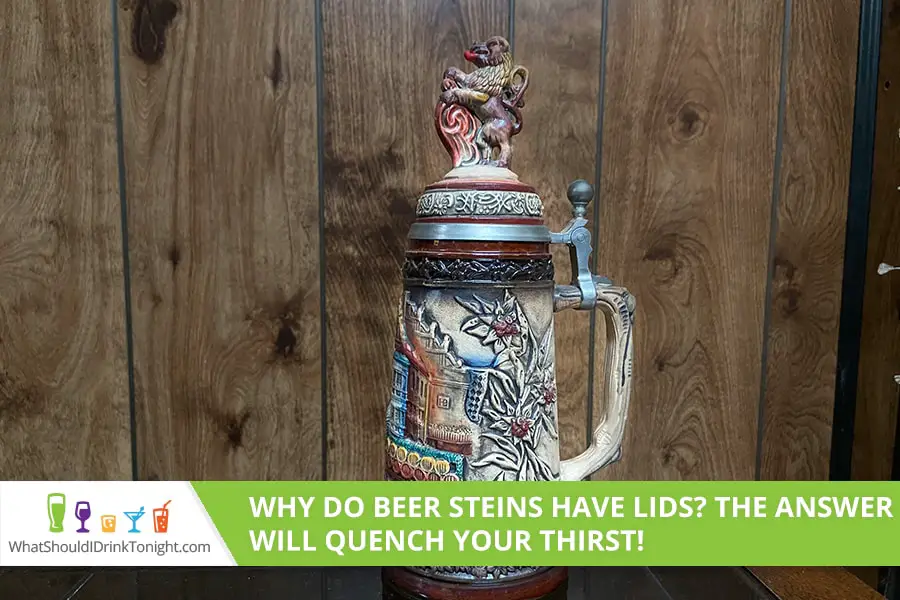I was at a friend’s house the other day and he was drinking beer out of a beautifully crafted beer stein which happened to have a lid on it. I asked him why the beer stein had a lid on it and he had no idea. I was curious so I did a little digging and found out some really neat things about beer steins, but first let’s get to the question at hand.
This is why beer steins have lids: After the bubonic plague struck Europe, several infestations of flies and mosquitos landed as well. To protect against the dangerous insects and as a sanitary measure, people began covering food and drink to keep out diseased flies. The beer stein lid was born. The lids come in handy now for preventing spillage and keeping the beer at a constant temperature.
Beer steins are beautifully decorated with different themes and although they were originally created to keep insects out of drinks, beer stein lids are highly decorative pieces that come in handy to prevent spills and warm beer. They can be made of different materials, varying styles, and a number of sizes. I’ve done a bit of research about all these things so keep reading to find out a bunch of interesting information on beer steins.
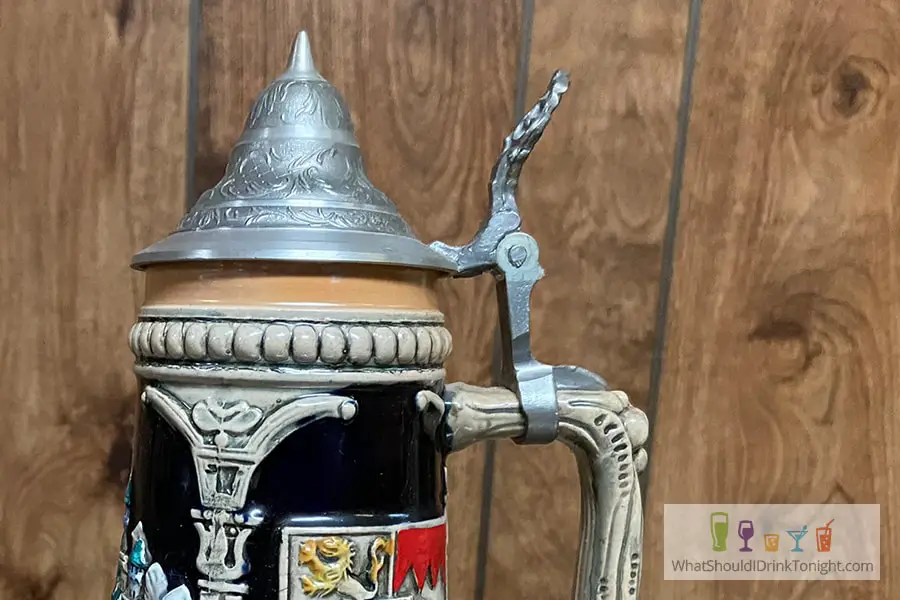
What Is the Lid on A Beer Stein For?
Preventing the spread of bubonic plague took all kinds of measures in the 14th century. Diseased flies were all about, and beer drinkers needed to devise protection. Today, the lids still serve a good purpose to keep fruit flies out, and they also help to keep beer at a constant temperature.
Nowadays you can find steins with or without lids, mostly serving a decorative purpose. Let’s find out a bit more about all the different kinds of beer stein lids out there.
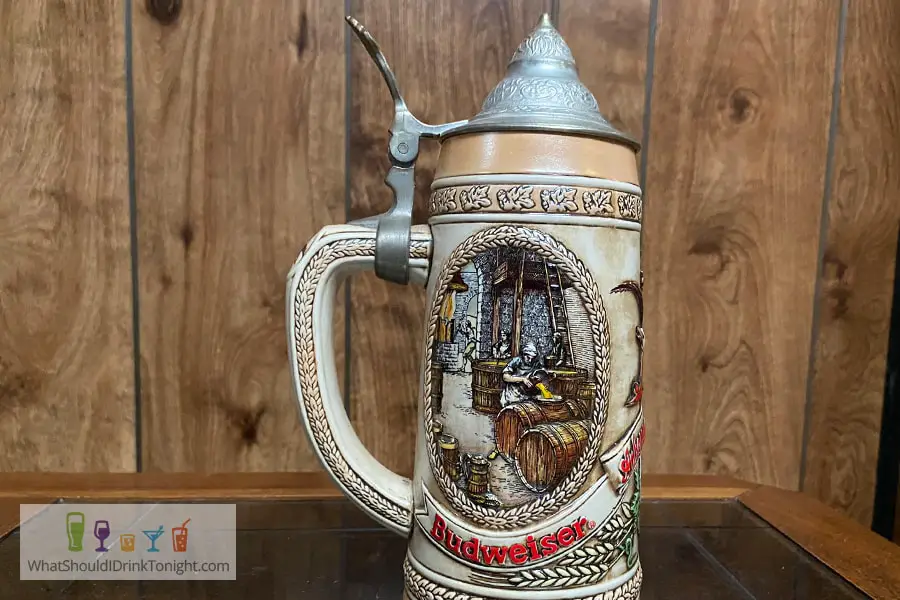
The Many Different Beer Stein Lids
Nowadays, the lid serves the purpose of adding a nice finishing touch to the stein. There are hundreds of different lids currently available, but the vast majority can be categorized into five different types.
- Ornamental – These lids are always pewter and are the most popular choice of lids for limited-edition type steins. The shape of this stein lid is typically conical with a finial at the top and they usually have a lot of details that require special craftsmanship.
- Conical – This is the cone-shaped lid that is usually made out of pewter but can also be made out of white base metal. These are the most common lids and least expensive and now are mostly machine-made. The surface gets plated with either a nickel to create a shiny finish or a pewter-like alloy to create a darker antique finish.
- Flat – These lids are also known as semi-flat lids, as they are not entirely flat. They are typically made from pewter and have a surface that is easy to add engravings too.
- Inlay – These are known to be very attractive lids, usually always with a pewter lid and flange with a stoneware figurine in the center.
- Figurine – Known as a top-of-the-line lid, mostly made of pewter with a figurine mounted on top.
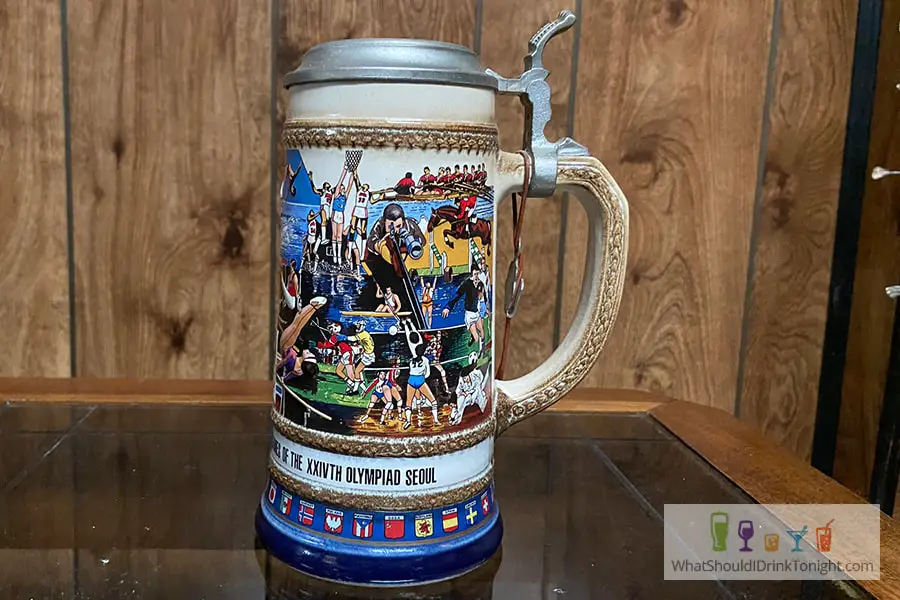
Benefits Of Beer Steins
A drinking vessel that once was used to help protect beer drinkers from the bubonic plague, beer steins have now become a staple in many pubs and breweries. Here are a few factors that make people believe that the beer stein is the perfect drinking vessel.
- Status symbol – Back in the earlier days, people who owned a beer stein were seen as having status in the community. It showed that they were someone who could afford small luxuries in a difficult time in the world.
- Durable – Beer steins are made with sturdy materials that are built to last through daily use.
- Memorable experience – Beer steins make great souvenirs to remember a beer or place you have enjoyed. And since they are so durable, they’ll last a long time.
- Better taste – Better tasting beer is all about personal preference. Those who love the traditional design and feel of a beer stein will often say that the flavor of the beer is better. It could be that the porous nature of the vessel helps add a flavor to the beer while the thick stoneware and the lid can help keep the beer at optimal temperature.
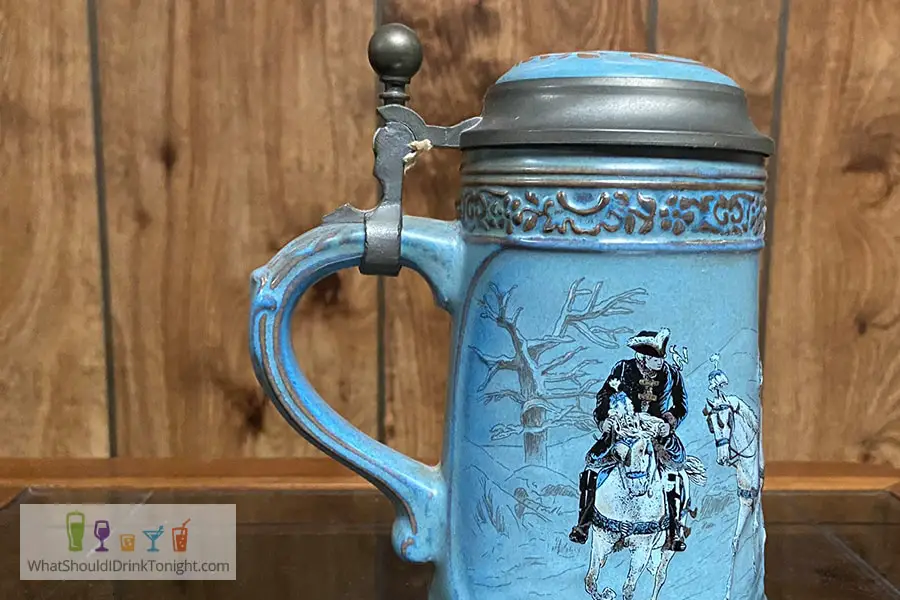
Beer Stein Sizes
Metric volume is the most common method of sizing a beer stein; one metric liter is 33.8 ounces. The most popular sizes of beer steins are the ¼ liter (8.5 oz), ½ liter (16.9 oz), ¾ liter (25.4 oz) and 1 liter (33.8 oz). The half-liter size is the most popular.
History of the Beer Stein Lid
As briefly mentioned in the opening section, after the 14th century, as a reaction to the plague, there was a law established in Germany that required any beverage containers to be covered for sanitary purposes. At that same time, different techniques to improve earthenware created stoneware, which then created the presence of stoneware drinking vessels.
By the end of the 19th century, the stein was defined as being made in Europe crafted from different materials like pewter, mainly in England, and glass, porcelain, and silver elsewhere in the region.
Over the centuries, many stein-decorating styles and techniques were developed and refined, resulting in the wide variety of craftwork and artistry we see today.

Types of Beer Stein Material
There are many different kinds of beer steins made these days. A lot of them serve the purpose of decoration or are given as souvenirs from different breweries. Many beer steins are still made with lids, while some are made without. Here are the different materials used to make most beer steins.
Pewter
Pewter is a compound consisting of tin, copper, and antimony. In Europe, pewter has a minimum of 92% tin and copper and antimony are added to harden the metal. The higher tin content means a more silvery color.
These steins are component cast, meaning that the lids, bodies, handles, and ornamentation are all separately made.
Crystal
Crystal is a clear, high-quality glass. The body of these steins are hand-cut, and either hand-engraved or engraved by a mold. Usually, these are mouth-blown and case-hardened with a transparent coloring on the exterior.
Glass
Glass is the least expensive of the most popular material used. Glass bodies and handles are made from a mold, and the lid is often attached by machine. The bodies are usually transfer-decorated which are the only handwork that is involved.
Ceramic
Ceramic steins fall into one of five categories according to the quality of the ceramic mass, raw materials, firing temperature, color, and density of the mass.
- Earthenware – Fired at a temperature around 1,000 °C, this is a colored mass that is porous until it is glazed.
- Ceramics – Fired at about 1,050 °C – 1,080 °C, this is a slightly porous, light-colored ware that must be glazed to be impermeable.
- Creamware – Fired at 1,150 °C and then again at 1,180 °C without a glaze and then decorated and fired again at around 900 °C-1,000 °C. This is a white earthenware with a lead glaze.
- Stoneware – Fired in high temperatures of 1,200-1,400 °C, this hard material becomes glass-like and has a result product of less than 2% porous so that glaze is not mandatory.
- Porcelain – Fired at temperatures of 1,300-1,400 °C, true porcelain is made of kaolin and petuntse. These ingredients produce a white, more or less translucent, glass-like material.
Ceramic Stein Decorations
There are a few different techniques used to decorate the body of a ceramic stein.
- Raised relief – This three-dimensional technique is easily the most popular. A highly detailed decorative area is raised above the background of the stein.
- Transfer decoration or decal decoration. The least expensive of the decorations. Because of modern technology, we can now produce great details of portraits, paintings, and photography that gets transferred onto the stein quite easily.
- Incised decoration or etched-decoration. This is a more complex and expensive technique, so it is not as popular. The subject outline of the stein is etched by hand into the body.
Well that pretty much exhausts my knowledge about beer steins and why they have lids on them. Hopefully next time you are enjoying a brew in a beer stein you can impress your friends with all you’ve learned here today!

